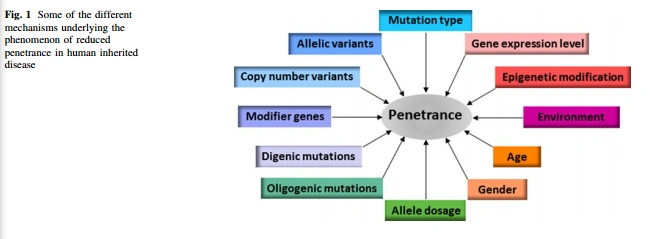Reduced Penetrance[]
Reduced penetrance is a factor that influences the expression of particular genetic changes. They usually affect autosomal dominant disorders but can also affect recessive traits as well (GHR, 2013) .
Human Disease Inheritance[]
In humans, reduced (or incomplete) penetrance occurs when individuals with a specific disease-causing mutation or genotype fails to exhibit some if not all of the disease's characteristics. This phenomenon might explain not only why genetic diseases are occasionally passed on from unaffected parents to offspring, but also why individuals can be unaffected despite containing a large number of these mutations in their genomes (Cooper, Krawczak, Plychronakos, Tyler-Smith, & Kehrer-Sawatzki, 2013).

Some of the different mechanisms underlying the phenomenon of reduced penetrance in human inherited disease. (Cooper, Krawczak, Polychronakos, Tyler-Smith, & Kehrer-Sawatzki, 2013).
The penetrance of a disorder is determined by the percentage of individuals harboring a particular genotypic mutation who express phenotypic characteristics of that disorder within an outlined time period. Measuring penetrance requires very large populations in order to help predict the likelihood that a trait will be exhibited for carriers of the affected alleles (Miko, 2008). If 100%, the disease and genes for that disease are said to show 'complete penetrance.' If less than 100%, then it is considered to have reduced (or incomplete) penetrance (Cooper, Krawczak, Plychronakos, Tyler-Smith, & Kehrer-Sawatzki, 2013).
Reduced penetrance can be the result of a combination of hereditary and environmental factors (Vitti, Cho, Tishkoff, & Sabeti, 2011). For example, phenylketonuria, a mutation resulting in mental disabilities, can be counteracted through a phenylalanine-restricted diet and the individual can lead a healthy life. Unfortuantely, not all examples of reduced penetrance can be so easily counteracted or understood. Osteogenesis imperfecta (OI) is another example of reduced penetrance. This one disease results in weak bones, bluish color in eye whites, and weak joints and teeth. Some individuals with this mutation exhibit no physical characteristics and are unaware of the possibility of passing the mutation to their offspring. This makes expression patterns for diseases unpredictable (Miko, 2008).
Epigenetic factors, anything that interferes with gene transcription or protein expression, can be used to explain reduced penetrance. Alterations or deletions to genes or proteins can prohibit specific genes from being expressed entirely or it can vary the degree at which that phenotypic trait is expressed. Marfan syndrome, for example, can be exhibited at different variations. Though all individuals affected have the same gene, it has been found that the location of the mutation on the gene controls the diseases severity.

Because the gene for polydactyly always causes extra toes in cats, but the number of extra toes varies between individuals with the gene, polydactyly is considered an example of variable "expressivity." Courtesy of Seabright Hoffman. All rights reserved.
Animals can also be affected by reduced penetrance. Cats sometimes exhibit extra toes, a trait known as polydactyly. This particular phenotype is associated with interbreeding but also shows variation between the number of extra toes from cat to cat. Not as severe or life-threatening as other diseases, this example of reduced penetrance indicates the vast spectrum in which gene mutations and expression can exist (Miko, 2008).
Sources
Cooper, D., Krawczak, M., Polychronakos, C., Tyler-Smith, C., & Kehrer-Sawatzki, H. (2013). Where genotype is nt predictive of phenotype: towards an understanding of the molecular basis of reduced penetrance in human inherited disease. Human Genetics, 132, 1077-1130.
Genetics Home Reference. (2013, October 29). What are reduced penetrance and variable expressivity. Inheriting Genetic Conditions. Retrieved from http://ghr.nlm.nih.gov/handbook/inheritance/penetranceexpressivity.
Miko, I. (2008). Phenotype variability: penetrance and expressivity. Nature Education, 1(1).